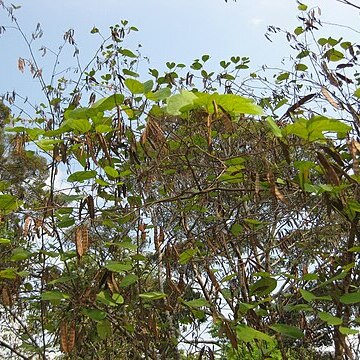Shrubs or small trees, to 3 m tall, dioecious. Young branches pubescent; older branches whitish. Stipules narrowly triangular and tapering, ca. 2 mm; petiole 2-3.5 cm; leaf blade suborbicular, 5-9 × 6-10 cm, papery, abaxially pubescent, adaxially glabrous, primary veins 7-9, base truncate or shallowly cordate, apex bifid to 1/2, lobes obtuse at apex. Inflorescence a raceme, 4-8 cm, 10-15-flowered, opposite with leaves; bracts 2-3 mm, pubescent. Flower buds narrowly fusiform, 6-10 mm. Hypanthium turbinate, short. Calyx spathe open on one side. Petals greenish white, obovate-lanceolate, 7-12 mm, shortly clawed. Male flower: fertile stamens 10 in 2 whorls, subequal, ca. 10 mm; anthers oblong, 1-2 mm. Female flower: reduced stamens present; ovary shortly stalked, 6-8 mm; style short; stigma peltate, small. Legume straight or slightly curved, linear, compressed, 5-7 × 0.7-1 cm, beaked; valves leathery, glabrous. Seeds 6-10, green, ellipsoid, slightly compressed, ca. 3 mm in diam. Fl. Mar-Jul, fr. May-Jan.
An erect shrub. It grows 1-4 m tall. The branches are thin and smooth. The leaves are divided at the tip into 2 lobes. They are red when young and become green when mature. There is a small triangle shaped stipule at the base of the leaf. The leaves are 7-15 cm long by 10-15 cm wide. The leaf stalk is 3-5 cm long. The flowering arrangements are at the top of the plant in the axils of the leaves. These are 5-15 cm long. The flowers are greenish. Male and female flowers are separate. The fruit are flat pods 5-7 cm long and 1 cm wide. There are 6-10 flat seeds. These are 3 mm wide.

